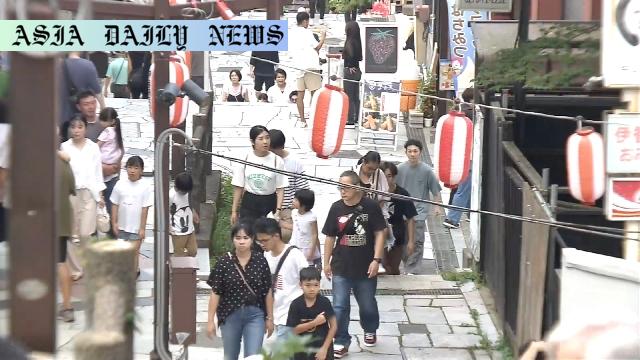Tourism in post-COVID Japan is experiencing a revival with government efforts to revitalize domestic travel in the face of a booming inflow of foreign visitors.
Key Point 1: Japan’s domestic travel efforts aim to counter a declining population and post-pandemic slumps.
Key Point 2: The Yukiguni initiative fosters local interaction, tackling labor shortages and promoting cultural exchange.
Key Point 3: Record spending by Japanese tourists highlights potential amidst a global tourism boom.
Key Point 4: Practical programs incentivize locals to explore and engage in new ways while boosting regional economies.

Japan’s Push for Domestic Tourism Revival
In an effort to address the challenges posed by a declining and aging population, the Japanese government has initiated a strategic focus on stimulating domestic tourism. A government white paper emphasizes that while foreign tourists have set record highs in visiting Japan and contributing remarkable amounts to its economy, the number of domestic travelers has yet to reach pre-pandemic levels. This disparity highlights the need for innovative strategies to bring local residents back to exploring their country’s cultural and historical landmarks.
The COVID-19 pandemic had a profound impact on travel habits globally, and Japan was no exception. Local participation in domestic tourism dropped significantly, down 8.2% compared to 2019 levels. Despite Japanese tourists spending 25.1 trillion yen on domestic travel in the last year, the volume of participants dropped notably. This data underlines a key trend: while economic recovery in terms of spending power is evident, practical measures are required to encourage more frequent local travel.
Innovative Programs Like Yukiguni
A standout initiative tackling this challenge is Yukiguni, where programs are designed to create immersive cultural experiences for local travelers. In partnership with seven municipalities, Yukiguni allows participants to engage in hands-on activities such as rice planting in rural areas like Niigata Prefecture. These programs not only foster deeper emotional connections with Japan’s rural heartlands but also provide labor support to aging communities struggling with a shrinking workforce. A Tokyo resident participating in such a program expressed her emotional fulfillment, vowing to return to help with rice harvesting, showcasing the success of this program in creating repeat visitors.
Programs such as these serve a dual purpose: they promote cultural awareness and exchange while addressing regional labor shortages. The government and local authorities are banking on such models to inspire residents to travel more and rediscover the less-traveled areas of their own country. Moreover, these efforts augment regional economies and create sustainable tourism models that benefit both visitors and host communities.
The Broader Economic Implications
The economic impact of reigniting domestic tourism in Japan is enormous. As international visitors continue to pour in, contributing record-breaking revenue to the tourism industry, there is immense potential to stimulate further growth by encouraging domestic travel. Programs focusing on cultural immersion, environmental sustainability, and community upliftment can pave the way for innovative solutions that not only boost local economies but also mitigate the socioeconomic challenges posed by demographic shifts.
Japan’s tourism renaissance is a testament to how crises can generate opportunities if addressed effectively. By learning from past policies and current needs, there’s a strong chance that more local residents will explore long-neglected gems within their nation. Such programs ensure that the nation’s vast cultural heritage is preserved, cherished, and economically vitalized.



Commentary
Reflecting on Japan’s Tourism Goals
As Japan pivots to revive its domestic tourism industry, there’s much to learn and admire about the innovative strategies being implemented. The country’s approach to addressing challenges stemming from an aging population and the shifting dynamics of travel post-COVID offers insightful lessons for other nations facing similar issues.
Initiatives like Yukiguni represent a bold stride towards promoting cultural exchange and regional development. What makes these programs especially noteworthy is their human-centered focus. By engaging locals in unique, enriching activities such as rice planting or harvesting, these initiatives serve as an emotional and practical bridge between Japan’s urban residents and its rural communities. These programs not only contribute to labor-intensive activities in rural areas but also inspire deeper connections between participants and their cultural heritage, setting them up as potential repeat travelers and even advocates for these regions.
From an economic standpoint, reviving domestic travel isn’t just a solution to offset international tourism growth—it’s a necessity for a balanced economic framework. With foreign visitors accounting for record spending, encouraging Japanese tourists to match this trend can stabilize regional economies and ensure that Japan’s wonders are sustainable for future generations. Moreover, multi-stakeholder collaboration, involving municipalities and local communities, ensures long-term success and adaptability in these programs. The success stories already emerging from such efforts hint at the untapped potential within Japan’s domestic tourism market.
Ultimately, Japan’s efforts to stimulate domestic tourism remind us of the value of rediscovering our own backyards. In an era where global travel can sometimes overshadow local exploration, these strategies offer hope for regions worldwide aiming to reconnect their citizens with their roots while bolstering economic and cultural sustainability.